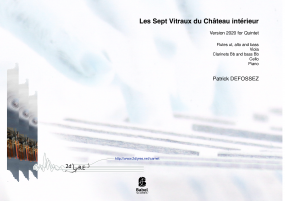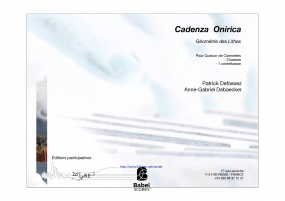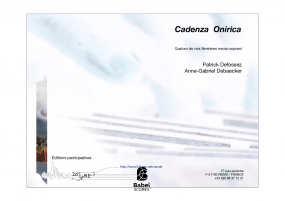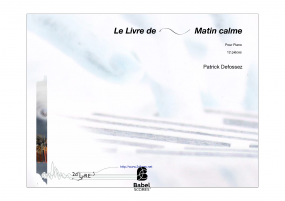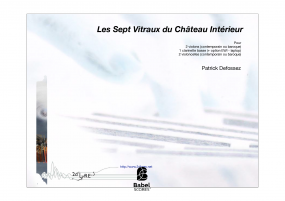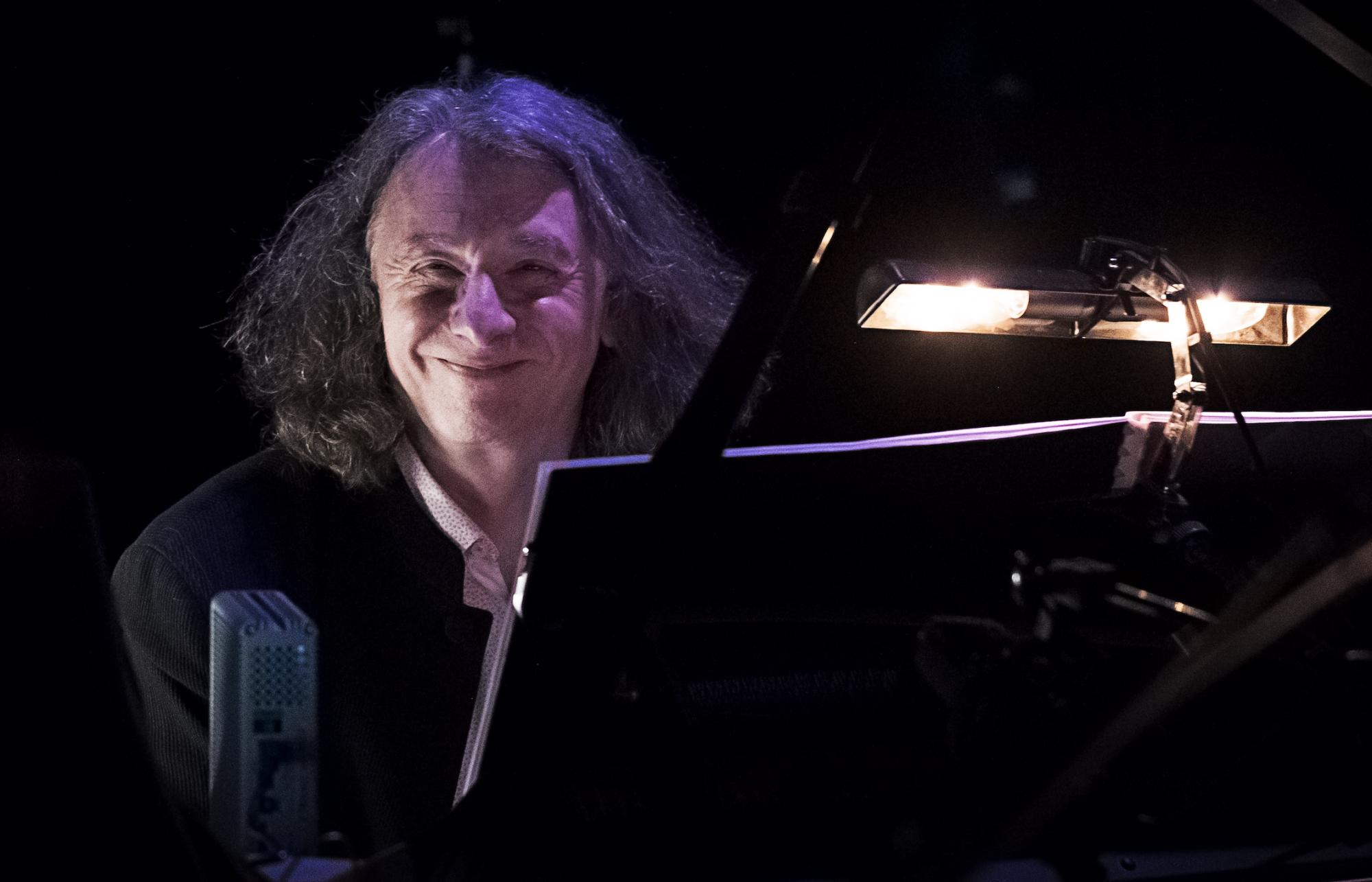
Patrick-Astrid DEFOSSEZ
Play all audio recordingsComplete biography from =>
http://en.wikipedia.org/wiki/Patrick_Defossez
Patrick Defossez (born 7 August 1959 at Valenciennes, France) is a Belgian composer, pianist and improviser of contemporary classical music. A Belgian citizen, he has lived in France for many years and divides his time between Belgium, Reims and the foothills of the Mont Ventoux. He is also the musical director of the 2d’Lyres not-forprofit organization and the Autres Voix de piano collective.
A classically trained musician, Patrick Defossez cut his teeth first at the Académie de Musique, then at Mons Conservatory, Belgium, where he wrote his first orchestral work in 1977. He then left for the United States in order to work on jazz and improvisation. He perfected his musical techniques at Berklee College, Boston.
After, he began working with electroacoustic music and mixed music, especially at the IRCAM music research institute. Under the guidance of Claude Ballif, he rounded his music composition studies off with the unanimous award of the prize for composition.
Patrick Defossez began his musical career in 1985, moving to France at a time when Belgian jazz was going through a very challenging period. Over the years, he put his creative talents as a pianist to work in the contemporary music scene, composing and improvising; played with several jazz bands (trios, quintets) and directed an ensemble featuring a wide range of different instruments which was part of the jazz fusion movement.
It was after being taught by Claude Ballif in mid-1994 that he really embarked on musical composition. He produced a whole series of pieces designed to be played in situ, which were often the result of commissions and personal meetings. These saw him perform in Reims Cathedral (1997), on the banks of the River Meuse (Cascades immobiles with the Septuor de Namureauphones, 2000) and in formats where he could enjoy the experience of blending genres and experiences, as in Rêves, ragas et raves (2001) performed in Nantes with the town’s Symphonic, Big-Band and University Choir. To mark the bicentenary of the death of Toussaint Louverture, he wrote the music for an opera, Tous un (2003), based on the libretto by Fabienne Pasquet.
These large-scale endeavours were accompanied by chamber music compositions, which frequently involved working with instrumentalists, such as Du haut… denum digitorium (2000), performed at the Pompidou’s Center - Paris by the bassoonist Pascal Gallois and the percussionist Samuel Favre. This is also how Re-partita /// post-ludio (2006) originated, composed at the request of violinist Jacek Friedrich, a paraphrase-remix of the prelude of the Partita for Violin N°3 by Johann-Sebastian Bach.
Patrick Defossez began working on pieces that would break down the barriers between genres and give rise to innovative or hitherto untried formats. For example, two very different approaches he tried were to bring three improvisers into a string ensemble for Vernissage, dialogues et bavardages and to combine electronic sounds with a range of traditional Landes instruments for Chemin d’ombres / Matsu Camin (2006). Patrick Defossez returned to playing piano solos in 2012. He composed Le livre de… Matin calme, a suite where he reflects upon sound and time, ‘in suspension, repeated, renewed, held in check, infinite’, a score that is ‘turned towards a thousand dawns’.
Patrick Defossez describes himself as a ‘pluriesthetic’ musician who attaches great importance both to the ‘art’ element of (so-called) contemporary classical music and to the influences derived from improvised music, from jazz and electroacoustic music. The stage environment and the physical lay-out of the venue are important parts of his work and some of his compositions (e.g. Sculpture de Muses in 2012) have been designed for specific locations. His experience as a jazz musician has led him to develop a technique of ‘improvised composition’ in which the written work is subjected to changes in real-time during the course of a concert, allowing for greater spontaneity of performance. This may be driven by purely aural considerations but also by a concern for how the playing of the piano as a visual performance is perceived. Having studied at the Beaux-Arts « I quickly noticed that I painted music and played sculpture » Patrick Defossez.
This breaking down of barriers goes beyond music, towards a form of synesthesia where words, images, sounds and space are components of the musical environment in their own right, a lesson learnt under Claude Ballif. On several occasions he has performed his music in conjunction with visual elements: paintings (Fondation Carzou) or animated works (soundtrack to a silent film), envisioning the concert to be a movement, an imbalance, a meandering, a journey, as much in the physical as in the temporal sense, one that also occurs in our mind’s eye. In the same way that his music has a transversal quality, Patrick Defossez’s lyrics and the names of many of his compositions frequently display great inventiveness and something of his flamboyant, irreverent side. This helps us to understand the process of the working and re-working of raw materials[3] from which new performance gestures are born. The works of Raymond Queneau (Injectertion) and Allen Ginsberg (Libr’Air) fit naturally into this vein, but other writers who might not have been immediately associated with this environment such as Henry de Montherlant (Inès de Castro), Louis Aragon (La messe noire d’Elsa) and Jean Genet (Le funambule) have also been ‘set to music’ by Patrick Defossez.
Patrick Defossez accords much importance to the crafting of instruments and to the performance gesture, so much so that he has explored the idea of a ‘digital conservatory’ of instrumental techniques. He readily uses rare and unusual instruments in his compositions: the bass oboe, a didgeridoo, ondes Martenot, the bass flute, the double bell euphonium, the electroacoustic harp, sound-producing sculptures like the Namureauphones, traditional Landes instruments etc. (but not yet a washboard!). These ‘meslanges’ are frequently joyful, blending both style and musical timbre, creating two distinct families of works, one of which tends towards the heterogeneous and the incongruous (perhaps drawing on the Belgian surrealist heritage?), while the other is an exploration of the performance gesture and the essence of musical time. In both cases, the performance gesture is crucial, this being the component around which the syntax of musical discourse revolves.
In 2011, he became the musical director of the duo Autres Voix de piano, which he formed with Anne- Gabriel Debaecker. The first important work has been Pourquoi tant de … ?, a framework-score designed to be modified in line with the guest musicians present. The first version of the work was developed by drummer Simon Goubert and was released as an album, receiving positive reviews. The duo then paid tribute to sculptor Parvine Curie at the Collégiale Saint-Martin, Angers as musical composition Sculpture de Muses, dance (Mathieu Ducouret), poetry (Yves Jouan and Valérie Rouzeau) and audio-visual performance art (Sylvie de Meurville) played off against each other (2012).[6] Further on, a new version of the Pourquoi tant de … ? framework, entitled Quatre = Onze == (7), has been elaborated with saxophonist Daniel Erdmann and trombone player Benny Sluchin, exploring the encounter of improvisation-based and classical practices of interpreting a score. The work was first played in public in October 2013 and will be released as a CD recording at the end of 2015 by the German label NEOS.
Member of : CDMC Paris, CeBeDem Bruxelles, Plate-forme des Musiques de Création Grand Est, Réseau national de la création musicale FUTURS COMPOSES Paris, SNAC, SACEM & SACD Paris, IRMA Paris, ADAMI-SPEDIDAM, Les Lundis d’Hortense Bruxelles, Forum Composers USA
Several web-links =>
Movie > Transdisciplinary opera’s show: 2018-2019 CO2-Cycle de Lieder - les chemins de la création => https://vimeo.com/435090471 mdp : mix (production Association 2d’Lyres) : interactive intermedia show and visual for an actor, a vocalist, a baroque soprano voice, a small ensemble of rare instruments, percussions, live électronic’s set and visual digital writings.
Early music from today :
• https://www.youtube.com/watch?v=VwcOVyuCJAg for quintet - Les Sept Vitraux du Château Intérieur - first concert 2015 USA.
Contemporary music :
• https://www.youtube.com/watch?v=jgOius6t604 for 4 bass-clarinets (with one conter bass-clarinet), female vocal quartet, percussion et quintet (vx, bassclar, pian per live electronic) - Cadenza Onirica - first concert 2017 France.
Contemporary music, electroacoustic, jazz and improvisation :
• https://www.youtube.com/watch?v=7gFuACYB-KQ solo piano’s concerto - Inspiration Impetuoso - first concert 2012 France.
Contemporary music, electroacoustic, jazz and improvisation, with visual :
• https://www.youtube.com/watch?v=OWHwjlVxKXcimprovised , improvised solo piano, electroacoustic/live electronic and Visual light drawings - Con alma - first concert 2012 France.
Jazz and improvisation :
• https://www.youtube.com/watch?v=txB3lMXVo6Y - Quatre = Onze ==(7) > CD - Neos Music Munïch Germany, among Best 2015 Magazine NewYork City Records USA and Pourquoi tant de…? CD - Leo Records England, among Jazz Stars 2013 of Culture Jazz France.
Chamber Ensemble (5 - 9 instruments)
Les Sept Vitraux du Château Intérieur Version 2020 for Quintet - Flutes ut, alto and bass/Viola/Clarinets Bb and bass Bb/Cello/Piano (2020)
Les Sept Vitraux du Château Intérieur Musique composée initialement pour le spectacle The Interior Castle - Compagnie Musica Aperta Washington DC États-Unis pour le 500ème anniversaire de la naissance de Sainte Thérèse d’Avila - Création mai 2015 - Boston États-Unis (2015)
Cadenza Onirica Géométrie des Pétales (2016)
Les Sept Vitraux du Château Intérieur Musique composée initialement pour le spectacle The Interior Castle - Compagnie Musica Aperta Washington DC États-Unis pour le 500ème anniversaire de la naissance de Sainte Thérèse d’Avila - Création mai 2015 - Boston États-Unis (2015)
Les Sept Vitraux du Château Intérieur Version 2020 for Quintet - Flutes ut, alto and bass/Viola/Clarinets Bb and bass Bb/Cello/Piano (2020)
Matin calme Le Livre de ... (2015)

